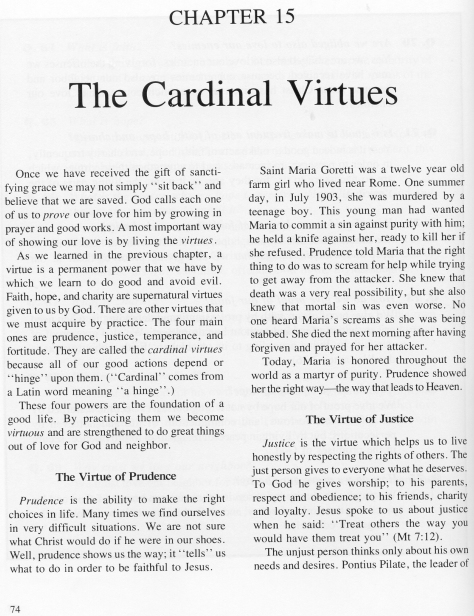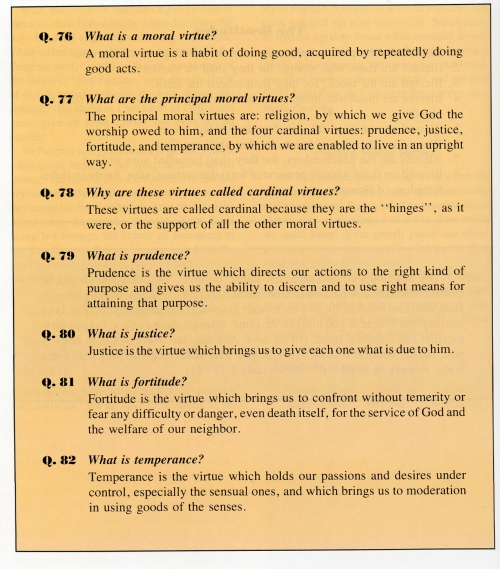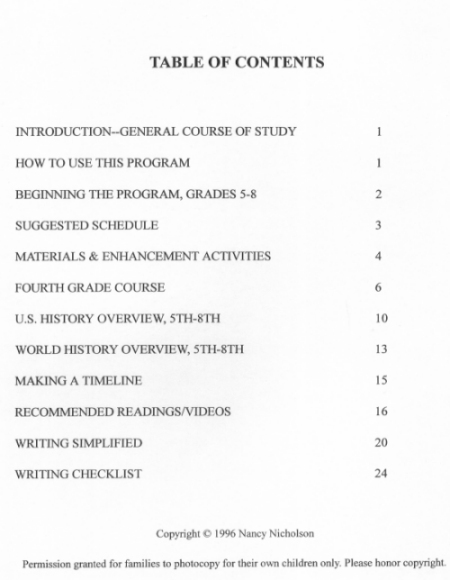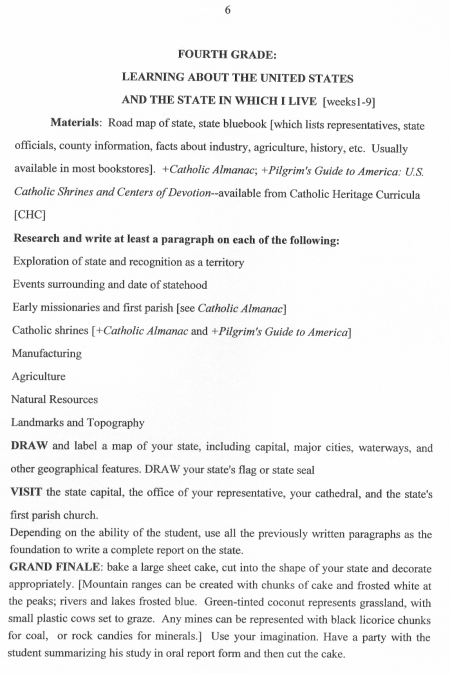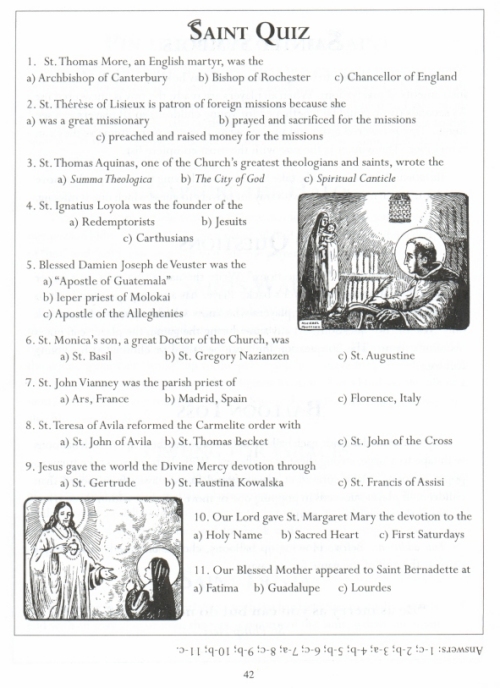Contents
Acknowledgments ix
Introduction and Helpful Definitions xi
About the Editors and Writers xv
The Soul of a Child xxi
Chapter I: Off to a Good Start> I
At the Crossroads 3
Socialization 7
Finding Our Niche 9
Entering God's Boot Camp: Our First Year 13
A Dad's Perspective 18
Making a List and Checking It Twice 2 I
Chapter 2: Sharing Our Philosophies 25
Thoughts on Beginning Home Education 27
Our Homeschooling Pentecost 30
At Home with Our Lady of the Rosary 36
Homeschool Preschool: Laying the Proper Foundation 38
The Early Elementary Years 42
Unschooling for a Change 46
Battling Burnout 5 I
What Is Classical Education? 53
Chapter 3: Resources for Basic Subjects 59
Teaching the Faith 61
Math in the Home 66
Effective Spelling Instruction 71
Ideas in Language Arts 74
Drew's Reading Journey 78
History Unfolding 81
Science Studies 86
Chapter 4: Ideas for Enrichment 91
Playing in the Dirt 93
Latin: Getting Our Toes Wet 96
Geography on the Go 98
Learning to Love Music 101
Teaching Art When You Are Not Artistic 104
How Much Is That Doggie in the Window? 109
Building Your Home Library 112
Chapter 5: How We Homeschool 115
Homeschooling in the Large Family 117
The Only Child 121
It Takes a Parish: Combining Work and Homeschooling 123
What We Do 130
Preschool Montessori-Style 133
Games: Purposeful Fun 140
Getting Grandparents Involved 144
Catholic Unschooling 147
Chapter 6: Support and Encouragement 157
Kids Speak Out 159
Finding Support in Cyberspace 162
From Grade School Teacher to Homeschool Teacher 166
Confessions of a Reluctant Homeschool Dad 168
APPENDICES
Appendix A Catholic Curriculum Providers 171
Appendix B Catholic Homeschool Resource Guide 175
Appendix C Catholic Websites 186
Appendix D Math Resource Guide 192
Introduction
We have produced this book to show what real-life homeschoolers do. There are certainly many ways to homeschool; from the structured curriculum to un-schooling, with all the permutations in between. Our purpose in compiling these essays is to give a sampling of how those in the trenches are successfully finding their way through the homeschooling maze. In these pages you will find the thoughts and ideas ofmany people. We, the editors, do not share every view expressed, but we feel called to give a voice to the rich variety of Catholic homeschoolers.
Please keep in mind that it is not our intent to tell anyone exactly how to homeschool. We offer this to you as a sampler of what homeschoolers are doing, wherever they are home schooling. The methods vary, for each family eventually settles upon its own unique style. Nonetheless, a common theme runs throughout. We all desire to raise and educate our children within the family. And we wish to share with them the richness and beauty of our Catholic faith.
If you are new to homeschooling, there are probably many terms and styles of teaching with which you may be unfamiliar. We include below a brief section of helpful definitions to guide you when these terms are mentioned. To help you further, we have placed resource guides in the appendices, which include ordering information for many of the items mentioned in this book.
Helpful Definitions
Child-led learning: See Unschooling.
Classical education: Broadly, education according to ancient or medieval models. More important to the Catholic homeschooling tradition is the model from the medieval universities that defined the seven liberal arts. These were grouped into the trivium consisting of grammar, rhetoric, and dialectic (logic); and the quadrivium consisting of geometry, arithmetic, music, and astronomy.
Etymology: Study of the origin of words and their roots.
Eclectic homeschooling: An approach in which one chooses from various methods and philosophies that which appeals to and works best for the individual family.
Phonograms: Small phonetic sound units that make up English words. (ow, ng, ou, etc.)
Readiness: The level of maturity and the knowledge-base that children need in order to progress educationally.
Relaxed homeschooling: An approach between work-text schooling and unschooling (see below). The parents often delay formal academics and wait for a child to show signs of readiness. They combine child-led learning with parent-initiated work.
Scope and sequence: A formal grade-by-grade list of the skills and knowledge that children are expected to master in school. You can find a scope and sequence on the Seton Home Study School web site (see Appendix C), in Kolbe Academy's general catalog, and in The Core Knowledge Series by E. D. Hirsch, Jr.
Spiral curriculum: Type of curriculum used by most schools. Topics are repeated through the years with greater depth each time. This repetition reinforces and builds upon the information and skills the students learned previously.
Unschooling: Term originally coined by John Holt, an educational reformer who has greatly influenced and helped the homeschooling movement. Whatever his original intent for the term, unschooling is now used to describe child-led learning. The underlying philosophy is that real life will provide a better education for children than textbook learning and that children are so drawn to make sense of the world they can be trusted to learn what they need to know, when they desire to know it.
Unit study: An approach that seeks to integrate learning by using a common theme throughout all subjects. Many people create their own modified unit studies by examining one topic in depth, while still using their main math and language arts texts.
Work-text schooling: Traditional textbook learning. Practitioners of this method seek to provide a thorough education to ensure that no educational gaps exist.
Socialization
Maureen Wittmann
I am a home schooling mother of five. Recently, a friend asked me the question that everyone asks, "What about socialization?" "Yes!" I shouted excitedly. "Yes, that is exactly why I homeschool." Judging by her perplexed stare, I do not think that was the answer she expected. She was surprised to find that homeschooled children are indeed actively engaged in the local community.
My home schooled children are not being deprived of social experiences. In fact, I do not think that my children are any less socialized than their public- or private-school peers. Rather than learning how to socialize with twenty-five other first-graders, my son is learning how to interact with people of all ages. And we hope he is learning how to be an individual.
Because I do not have the profound responsibility of keeping so many little ones motivated and disciplined, formal schoolwork takes less time for me and for my children. This allows us to get out of the classroom and experience real life. I do not have to worry about permission slips and scheduling transportation. I can load my kids into our trusty minivan, and we are off on an impromptu trip to local points of interest. Since we can take school with us, we have been able to experience museums and cultural events in other cities as well.
My children have ample opportunities to interact with other children. Local homeschool support groups have so many organized activities families are able to pick and choose. There are academic clubs, organized sports, community service organizations, social clubs, and more. Of course, there are our neighborhood friends too. It is not uncommon to pass our house and see five to ten kids playing together.
We socialize with a diverse group of people. Homeschoolers come from a variety of cultural, religious, and economic backgrounds. I believe that by promoting educational choices we are adding to the cultural richness of our society. Kids in public schools, private schools, and homeschools all have something unique to offer our society.
As you can see, my homeschooled children are not leading a sheltered life. Yes, my husband and I hold them close, but they will fly when they are ready. In the meantime we are able to foster their emotional security. We are protective of the children. We know that the day will come when they are faced with pressures to try drugs or to engage in sexual activity before marriage. We will do our best to protect them until they are prepared to face those pressures head-on.
Someone once told me that the moral child is the socialized child. We cannot expect our children to play and share with others if we do not teach them basic rules of moral conduct, such as not to steal and not to lie. We strive to teach these lessons and set a good example in our home. Is home schooling for every family? No, but it's right for our family, and socialization is only one of the many reasons we love homeschooling.
Finding Our Niche
Rachel Mackson
I am in the unique situation of having been homeschooled as a child, for one year, while living overseas. Thus, when I decided to homeschool my own children, I automatically sent for materials from Calvert School, the program my mother had used. I did not know that Catholic curricula existed. Calvert supplies a detailed, thorough package filled with creative teaching tips, but even so, I desired a more Catholic alternative. I soon heard of Seton Home Study and was elated to find that the director, Mary Kay Clark, had written Catholic Home Schooling. Her advice on Catholicizing our home and curricula was inspiring. Covering the basics was the focus of my early homeschooling. My son was not ready for a formal first grade or lots of written work since his motor skills and ability to sit quietly were still developing. For academic direction, I followed the advice of Seton and used the secular math workbooks by Modern Curriculum Press (MCP). These workbooks incorporate basic arithmetic and simple problem-solving, but I wanted more for our math studies. I bought a set of pattern blocks and played card games like blackjack with my children to reinforce addition and subtraction skills.
I was unsure, however, about teaching a child to read and was often caught short by my son's questions. Fortunately, a friend recommended Sound Beginnings, by Julia Fogassy. This program, which can be purchased from the Emmanuel Books catalog, offers specific, easy-to-use suggestions. To round out this first-grade curriculum, I ordered Child's Bible History, The Usborne Complete First Book of Nature, and Our Life with Jesus (Faith and Life series) and read them out loud.
We continued, studying in fits and spurts; taking breaks as needed for the birth of a baby or the myriad interruptions that life throws at a family. We pursued passing enthusiasms where they took us, and these surprisingly produced a great deal of learning. Mostly, I read books to the children. There were many days when I felt that nothing educational was accomplished, but we made steady progress. Occasionally, one of my children had a sudden burst of insight or showed signs of deep thinking, but for the most part we plugged away like the Little Engine That Could.
Around the time of my son's second-grade year, I felt confident in my ability to cover the basic subjects and ventured further afield. In searching for products to enliven our schooling, I managed to waste quite a bit of money. Then one day, as I was reading The Tortoise and the Hare aloud to my children, I was struck by the parallel to home schooling. Children do learn in giant leaps and bounds, which is valuable. But my role as a homeschool teacher was to help the children persevere during the slow times. Our small amounts of daily study were adding up.
This insight was the turning point in our homeschooling. I could relax knowing that there was no need to rush through our studies. As long as the child excelled academically, we could take our time because intelligence does not go away. On the other hand, if the child was behind in a subject, we could still make slow and steady progress that would win in the end. This revelation led me to stick with basic, inexpensive materials.
Rarely have I used a program enough to justify a high price tag. Elaborate graphics and educational content are unrelated. I use the money saved to purchase good books. Nonetheless, I make exceptions for solid Catholic material or programs made especially for homeschoolers. Sometimes material published for a small market must be priced higher than that which is mass produced. If the content is superior, the difference in price is worthwhile.
As my children continued growing, I tried something new. Instead of planning the third-grade curriculum in advance, I bought only a basic math book, a catechism, and quality literature reprinted by Bethlehem Books. It was fortunate that I saved the money because later in the year a friend showed me the Catholic National Readers, which she had purchased from Kolbe Academy. Readers from this set are now my son's favorite books. I also discovered Catholic Stories for Boys and Girls , a marvelous collection reprinted by Neumann Press.
Third grade was a welcome transition. My son became ready for more written work and was able to concentrate for longer periods of time. He slowly changed from a restless young boy to a student capable of sustained work. This transformation led me to appreciate homeschooling all the more. I had waited for my son to indicate signs of readiness, and when he showed the maturity necessary for formal schoolwork, he was not held back by tempo- rary obstacles. We addressed the rough spots and then moved on.
I too have undergone a transformation. My knowledge and experience have increased, and I am confident in my ability to determine what works and what does not work for our family. I can now answer questions as they arise and lead a child on to a higher level of understanding. I also have a house full of wonderful books that I have accumulated through the years. Our learning occurs in many different ways, through planned work in texts, through enriching field trips, and through spontaneous interests.
My children are reaping the benefit of my experience. While teaching my firstborn, I also received a good education. Over the years, we have become a true home-educating family. Our family has found its niche: that niche is home education.
Education commences at the mother's knee, and every word spoken within the hearsay of little children tends towards the formation of character. -Hosea Ballou, MS. Sermons.
